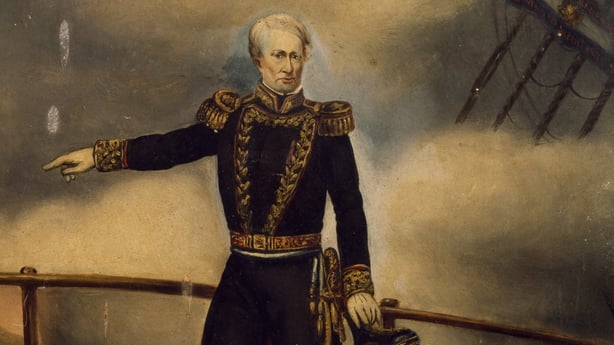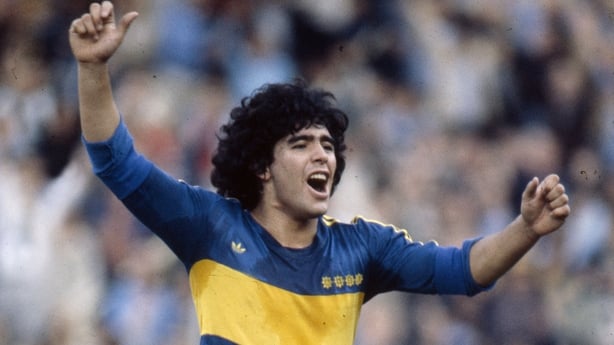While we can't claim Diego Maradona or Leo Messi as Irish, the World Cup has revealed a link between Ireland and Argentina thanks to Alexis MacAllister, the Brighton midfielder whose father Carlos also played for Argentina.
Assumed by many to have Scottish heritage, it became known recently that his family origins were actually in Donabate, Co. Dublin. The McAllisters as they were originally named were not alone. Argentina has the fifth highest Irish migrant population in the world and the largest for a non-English speaking country, so the connection between our countries is deep.
Irish immigration to Argentina was strongest in the second half of the 1800s. Counties Westmeath, Offaly, Longford and Wexford in particular have strong bonds with Argentina. The opportunity to progress in farming had an appeal as did the fact that Argentina was a largely Catholic country. The integration of the Irish provides some interesting links to soccer in the land of silver.
You’re doing something right to get a football club named after you and Guillermo Brown really must have done something right having four football teams in Argentina named after him. From Foxford, Co. Mayo, William Brown went into the military in his new homeland and is regarded as the Father of the Argentine Navy.
Three of the clubs are in Buenos Aires Province. Club Atlético Almirante Brown also known as Brown de Arrecifes was founded by Argentine Irish José Ryan and an Argentine German called Stegmann so adopted green and black stripes as a nod to their heritages.

Then there’s Club Almirante Brown in yellow and black, Club Atlético Brown or Brown de Adrogue as they’re also known, and then Club Social y Atlético Guillermo Brown based in Chubut Province.
None of the teams are in the Primera División but three currently play in the second tier.
Another Brown with a possible link to Ireland is José Luis Brown who featured for Argentina at the 1986 World Cup and scored a header in the final. Although his Irish heritage has never been officially confirmed, there is a belief that he has family connections in Kerry or Carlow.
Going back to clubs named after people gives an obscure Irish connection. Club Atlético Vélez Sarsfield was founded by three Argentines who were based in the barrio of Vélez Sarsfield. They were playing soccer one day when it started to rain, taking shelter in the railway station that bears the name Vélez Sarsfield, they decided to form a club and named it after the railway station.
The barrio and railway station takes its name from Dalmacio Vélez Sarsfield whose mother Rosa had Irish heritage through her father Jorge Sarsfield. Dalmacio was a lawyer and politician who wrote the civil code of Argentina that was in place between 1869 and 2015.
The football club has gone on to become one of the most successful clubs in Argentina, winning numerous trophies and producing many top class players. As successful as they have been, they pale in comparison to Boca Juniors.
Even though he spent five years at Argentinos Juniors, Diego Maradona is often associated with the Boca Juniors club in the colourful working-class area of La Boca. The club are perhaps the country’s best-known club internationally.

Founded by five Italian immigrants in 1905, however an important figure in the early development of the club was Tipperary man Paddy McCarthy. Paddy was an English and PE teacher in a city school headed by Clare man James FitzSimons and became the first trainer at Boca Juniors helping guide the club through that rough early stage where it could easily all fall to nothing.
Thanks to Paddy’s work the club thrived from the beginning enjoying local league success and in 1913 joining Primera División where they’ve remained since with themselves and River Plate becoming the two most famous Argentine clubs.
Paddy was a member of the sports municipal committee and in this role his training of locals in the barrios helped bring soccer to the masses, moving it away from the elite who had been playing the game.
Many people have wondered if the Boca Juniors jersey with its blue and yellow hoop is connected to Tipperary where Paddy was from, but Paddy had left Tipperary in 1900 and county colours weren’t adopted until later.
The official story is that the colours were chosen by members watching the boats coming into port and the next boat that came in carried the Swedish flag and so those colours were adopted.
Boca Juniors wasn’t Paddy’s first involvement at training. He was originally involved with Lobos Athletic Club whose roots were in the Argentine Irish community of Lobos city, 100km from Buenos Aires city.
Lobos was a city of immigrants and they were drawn to playing soccer. At the heart of the club founded in 1892 were Tomás Moore and Tomás McKeon. Both wanted and needed the team to escape the boredom of the city and entertain the local youths.
Moore was the first team captain with Edmundo Kirk as first president. The club was the first in the provinces and played its early games mainly against city teams. The club had tried to help establish clubs closer to home. Among these were the Salto Athletic Club based around two ranches run by Irish Argentines, while in Rojas the Irish Argentine Football club was founded and faded after brief success.
Initially playing in blue and white, Lobos changed to red and black in 1894, colours they’ve maintained since. The team finished second in the Argentine league in 1898 and 1899 at a time when the league was amateur. In 1899 they would also become the first Argentine team to play abroad when they played in Uruguay.
Around the same time, the Argentine League forbade teams outside 30kms of the capital, which meant Lobos could no longer compete. Paddy McCarthy would train the team in the early 1900s before helping Boca Juniors.
In 1902, three former Lobos players were on the Argentina national team that defeated Uruguay 6-0 in the first international match for both countries. These players were among eight former Lobos players now playing for Alumni, the team that dominated Argentine soccer in the first decade of the 1900s.The three players were Walter Buchanan, Carolus Buchanan, and Juan Moore who was captain.
🇦🇷v🇦🇺
— RTÉ Soccer (@RTEsoccer) December 3, 2022
Argentina 🤝 Ireland
Alexis Mac Allister knows all about his Irish heritage, all the way to Donabate.
📺 Watch live on @rte2 and @rteplayer: https://t.co/1ncBhVfkOd
📱Live updates: https://t.co/AIFeCDfUO8#FifaWorldCup #RTEsoccer #ARGAUS pic.twitter.com/juaAQTDRFO
Among their team-mates was Eduardo Duggan who played for Belgrano Athletic. The team also included the Brown brothers, Ernesto and Jorge who were of Scottish heritage. Today, Lobos play in a regional league and also offer a number of other sports as well.
According to historian Victor Raffo, in 1895 a soccer club was formed in Buenos Aires city by students of Irish heritage who wanted to take on the English schools and companies. They called themselves Club Atlético Capital but there was one major problem. They couldn’t even afford a football.
The students pooled their money together and backed it on a long shot horse called Porteño who came in good, giving them the funds to buy footballs, kits, boots, and medical equipment. As a tribute the club changed their name to Club Atlético Porteño.
In the early years, Irish names were very much in charge. The President was Tomás Gahan, the team captain was Francisco Geoghegan and among their honorary Presidents was Guillermo Bulfin, editor of leading English newspaper The Southern Cross.
They joined the newly formed Argentine second division in 1899 finishing sixth out of nine. They were promoted in 1907 and lost a championship play-off to Alumni in 1911, by then though the Irish influence could no longer be seen on the pitch.
The team did win the League in 1912 and 1914, albeit this was the dissident league which had broken away from the Federation. Argentine soccer turned professional in 1931 but the club chose to remain amateur, football faded and rugby rose in the club. The club still exists today as a rugby club.
Rugby was another sport were the Irish made an impact while Gaelic games, particularly hurling, was very popular up until the 1920s. The Irish also contributed to Pato, a horse sport that is the official national sport of Argentina, but soccer is clearly the passion of the people and the Irish, along with the English and Scottish, played their part in spreading the football faith in the country.
Samuel Kingston is a historian from Clonakilty who is currently researching a book on the Irish impact on sports around the world.
Follow the 2022 World Cup final between Argentina and France via our live blog on RTÉ.ie/sport and the RTÉ News app, watch live on RTÉ2 and RTÉ Player or listen live on RTÉ Radio 1's Sunday Sport.






